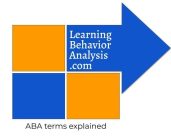B-7: Define and provide examples of automatic and socially mediated contingencies ©
Want this as a downloadable PDF? Click here!
Target Terms: Automatic Reinforcement, Socially Mediated Reinforcement
Automatic reinforcement is also sometimes called sensory reinforcement.
Automatic Contingencies
Definition: Behaviors maintained by automatic contingencies can be said to produce their own consequences, without another person changing the environment in any way in response to the behavior of interest.
Example in everyday context: Scratching an itch; rubbing sore muscles.
Example in clinical context: A patient engages in rocking back and forth on the floor to experience a reduction in anxiety (aversive private event). He is experiencing automatic negative reinforcement.
Example in supervision/consultation context: A student is sitting at their desk working on their assignments. They are repeatedly tapping their foot against the side of their desk. The teacher asks the student, “Why are you tapping your foot?” The student replies, “I like the sound it makes!”
Why it matters: All humans engage in some type of automatically reinforced behavior. On occasions, these behaviors may become disruptive to a person’s life. Automatically reinforced behaviors should not be targeted for intervention unless they are dangerous or causing harm to the client (e.g., head banging, eye-gouging, picking teeth, biting self) or significantly disrupting the lives of the client or others (loud vocalizations throughout the day, long ritualized behaviors that prevent learning adaptive skills).
Socially Mediated Contingencies
Definition: Contingency delivered in whole or in part by another person.
Example in everyday context: You get together with a group of friends. One of your friends asks you to “tell the joke” that always makes people laugh. You tell the joke and all of your friends laugh. Your joke telling behavior is maintained by socially mediated reinforcement (in this case, a specific kind of attention from friends).
Example in clinical context: A client who lives in a residential treatment facility engages in pinching staff. Each time the client engages in pinching staff, they give the client a break to “calm down.” The pinching behavior is maintained by socially mediated negative reinforcement (access to a break).
Example in supervision/consultation context: During group supervision, a supervisee engages in a lot of calling out and cutting people off. Every time they do this, the supervisor provides a mildly displeased facial expression. The supervisee’s behaviors of calling out and interrupting others decrease. Those behaviors were followed by a socially mediated positive punishment contingency.
Why it matters: As human beings, we have frequent interactions with other people. A large portion of our reinforcement contingencies are shaped by these interactions.
